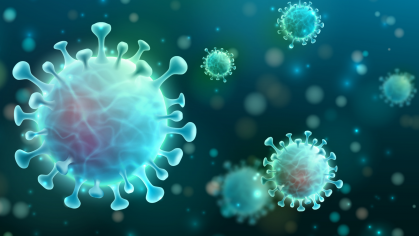Molecular Beacons Technology Invented by Rutgers Researchers Used in Widely Available, Rapid Abbott ID NOW COVID-19 Test Kits
Amid the continuous need for COVID-19 test kits, Rutgers technologies once again prove invaluable to the fight against the pandemic that is sweeping the nation and the world. A recent COVID-19 rapid test that received FDA emergency use authorization includes molecular beacons technology, which was invented by Rutgers University researchers.
Molecular beacons are highly specific, fluorescently labeled probes that identify and light up COVID-19 genomic RNA if it is present in a clinical sample. These probes are employed in the Abbott Laboratories ID NOW COVID-19 assay, which takes less than 15 minutes to complete, and runs on more than 18,000 assay instruments that are distributed throughout the United States. These clinical tests utilize a “Nicking Enzyme Amplification Reaction” (NEAR), which is an exponential nucleic acid amplification method developed by Abbott’s subsidiary, Alere, Inc.
Molecular beacons technology was invented and perfected over a ten-year period by Rutgers faculty members Sanjay Tyagi, Fred Russell Kramer, Salvatore A. E. Marras and David Alland and by researchers Paul Lizardi, César Guerra, Jacqueline Vet, Hiyam El-Hajj, Hilda Lomeli, and Amy Piatek.
Rutgers professor Kramer said, “As molecular diagnostic researchers, it is gratifying when you can help improve lives in a meaningful way, especially during times like these amid a global pandemic.”
Molecular beacons technology has been described in seven different patent families and has been licensed non-exclusively to more than 70 different companies and laboratories throughout the world.
Kramer was asked about the Rutgers researchers’ journey in inventing and developing molecular beacons technology and about its potential impact in the fight against the coronavirus pandemic.
What are molecular beacons and how do they work?
Molecular beacons are fluorescently labeled probes that can bind to a target nucleic acid if it is present in the test solution. When no targets are present, the fluorophore at one end of the molecular beacon and the quencher of fluorescence at the other end are in contact with each other and the probes are dark. However, if a target RNA (such as an exponentially amplified COVID-19 RNA) is generated in a clinical assay containing molecular beacon probes, the molecular beacons wrap themselves around the amplified target nucleic acids, changing their shape, which separates the fluorophore from the quencher, and the molecular beacons then shine brightly in their characteristic color, signaling the presence of the target. The attached picture illustrates this transformation.
How have molecular beacons revolutionized diagnostics?
Molecular beacons are added to the solutions in which clinical assays are carried out, and the reaction tubes are sealed before amplification of the target occurs. The test tubes are never opened again. The only things that leave the test tube are the differently colored fluorescent signals that indicate which target molecules are present and, by virtue of the time it takes to generate those signals, the results indicate how abundant were the different targets in the original sample. Because the test tubes remain sealed, the amplified targets cannot escape to contaminate samples that have not yet been tested.
Tell us about some clinical tests that currently employ molecular beacons technology.
The bioMérieux NucliSENS EasyQ Human Immunodeficiency Virus Assay for the AIDS virus is used throughout Europe and is the principle HIV-1 test used in China, Africa and other countries in the developing world.
The Cepheid GeneXpert MTB/RIF Mycobacterium tuberculosis PCR Assay takes less than two hours to determine from a sputum sample whether a patient is infected with TB, how abundant the bacteria are in the sample, and whether those bacteria are resistant to the antibiotic rifampin, which is indicative of multidrug resistance (necessitating a longer course of treatment with additional antibiotics).
The Becton Dickinson GeneOhm Group B Streptococcus Assay determines whether a pregnant mother that is about to give birth is infected with this bacterium, which can be transmitted to the baby during birth and can cause blindness, deafness and death. If this rapid test is positive, the mother is injected with powerful antibiotics that pass through the placenta to the fetus, and the babies are never infected. This assay prevents 10,000 babies from dying from meningitis each year in North America.
What is new in your laboratory?
When cells die, their contents are broken apart and fragments of the cell’s genetic material transiently enter the blood stream. In collaboration with Diana Vargas, we have been developing rapid, low cost, gene amplification assays that selectively amplify target mutant DNA fragments in a routine blood sample that arise from cancer cells in a patient; and the assays utilize molecular beacons to detect the amplified DNA fragments. These somatic mutations (i.e. mutations that are not inherited, but that arise in cancer cells during a patient’s lifetime) are rare, and they are hard to detect because the blood contains abundant DNA fragments from normal cells. Our laboratory, in research carried out during the past eight years, has developed an extremely sensitive assay method that selectively amplifies only the mutant DNA fragments. The particular mutations that are identified in these assays enable the selection of an effective targeted therapy that kills the cancer cells containing those mutations. Since these assays utilize routine non-invasive blood samples that can be taken frequently, the success of the targeted therapy can be followed, and the therapy can be changed in response to the occurrence of new mutations.


